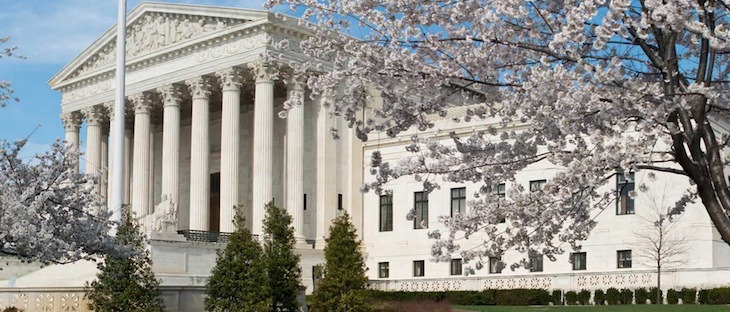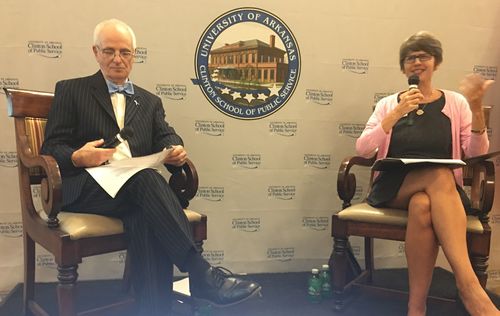U.S. Supreme Court in flux could decide Planned Parenthood funding
by September 24, 2018 5:57 pm 689 views

The U.S. Supreme Court will consider numerous important cases in the fall term that begins Oct. 1, including one that could determine whether Arkansas Medicaid recipients can seek care in a Planned Parenthood clinic. Decisions will come from a court in flux with only eight justices and without its swing vote in retired Justice Anthony Kennedy.
Those observations came from Theresa Beiner, dean of the University of Arkansas at Little Rock School of Law, and John DiPippa, dean emeritus. The two spoke at the Clinton School of Public Service Monday, the same day that the eight justices were meeting in their annual Long Conference to consider which cases to hear in the upcoming term. The first of those cases are expected to be announced Thursday.
Among the cases to be considered is whether states including Arkansas can cancel medical services agreements with Planned Parenthood. At issue is whether Medicaid recipients have the right to choose their own providers.
Only about 1 percent of petitioned cases actually are heard – 71 in last year’s term. A primary factor is when federal circuit courts have issued conflicting rulings. Such is the case with state funding of Planned Parenthood, where the 5th and 10th Circuits have ruled Medicaid recipients do have that right, while the Eighth Circuit has said no. Arkansas is in the Eighth Circuit.
Beiner said another case that could be considered is whether Title VII of the Civil Rights Act of 1964, which prohibits employment discrimination based on factors such as race and sex, applies also to sexual orientation.
Other cases to watch include two that challenge the boundaries of the Constitution’s dormant commerce clause, which says Congress has power over interstate commerce and that states cannot unduly burden it. Those cases include a Massachusetts law prohibiting sales of products created as a result of animal cruelty, and a California law regulating egg sales. Another case could decide if a World War I memorial in the shape of a cross must be removed or destroyed.
Beiner and DiPippa spoke about a Supreme Court whose makeup is still unknown, as the Senate has yet to vote on President Trump’s latest nominee, Brett Kavanaugh. Kavanaugh has been accused by two women of committing acts of sexual misconduct against them decades ago while in high school and college. He has denied the allegations.
Kavanaugh would replace Kennedy, who has retired. Kennedy often has been the swing vote on a court that voted 5-4 in 26% of the cases decided last term. Seventy-four percent of the 5-4 decisions were conservative victories. He was in the majority 84% of the time.
“He clearly was the center of gravity for the court in those 5-4 decisions,” DiPippa said.
Meanwhile, 39 percent of last year’s cases were decided through some kind of unanimous decision, though in some of those cases the justices offered different reasonings. Justices were in complete agreement 26% of the time.

Beiner and DiPippa presented a chart showing Kennedy occupying a middle ground between liberal and conservative decisions, while Justice Clarence Thomas was the most conservative and Justice Sonia Sotomayor was the most liberal. The chart showed the various justices occupying distinctive paths along the chart, as opposed to previous decades when members might occupy similar paths.
Kennedy was the key vote on a number of controversial issues, including abortion, same-sex marriage, race-based affirmative action, and climate change regulations. All of those involved weak precedents and could be affected by a justice more conservative than Kennedy.
Beiner said Chief Justice John Roberts could stake a position as a swing vote now that Kennedy has left the court. Roberts and the court’s liberal justices were in the minority in a 5-4 decision last term in South Dakota v. Wayfair, Inc. That decision allowed states to require out-of-state sellers to collect and remit sales taxes. He argued that Congress should change the law rather than the courts, and he has consistently shown a preference for respecting precedent.
The chief justice decides who writes the opinion when he or she is in the majority. When not, the senior member of the majority makes that assignment. Previously, that would have been Kennedy on cases decided by the conservatives. Now, it will be Thomas, who is farther to the right.
Beiner said the court potentially could revisit the non-delegation doctrine, which states that Congress cannot delegate its duties to another branch. The doctrine hasn’t been used to decide a case since 1935, and in the meantime executive agencies have passed regulations that could be interpreted as a violation of it. But this time, the court is considering a sexual offender registration notification act that could awaken that doctrine and help lead to other administrative actions being struck.
Regardless, Kavanaugh’s history suggests he would interpret the government’s regulatory authority more narrowly than other justices have done, DiPippa said.
Following are other important cases last term.
• Trump v. Hawaii, where the court upheld President Trump’s travel ban affecting certain countries, most but not all of them majority Muslim. It ruled that the order was not based on religious discrimination.
• Masterpiece Cakeshop, Ltd. v. Colorado Civil Rights Commission. The court ruled the commission had displayed religious hostility against a Colorado baker who declined to bake cakes for a gay wedding. That case was merely sent back to the state, and the baker faces another complaint.
DiPippa said that neither decision settled the issue. Moreover, the court used conflicting logic in the two cases. In Trump v. Hawaii, it ignored comments by President Trump that seemed to suggest it targeted Muslims. In the Masterpiece case, however, it based its decision on comments made by commissioners.
Other important decisions last term let states legalize sports gambling, disallowed a Minnesota ban on political apparel in polling places that is similar to Arkansas’ ban, and overturned a California law requiring crisis pregnancy centers to post information regarding obtaining abortions.
The court avoided making a decision in Gill v. Whitford regarding partisan drawing of voting district lines, saying the plaintiffs lacked standing.
